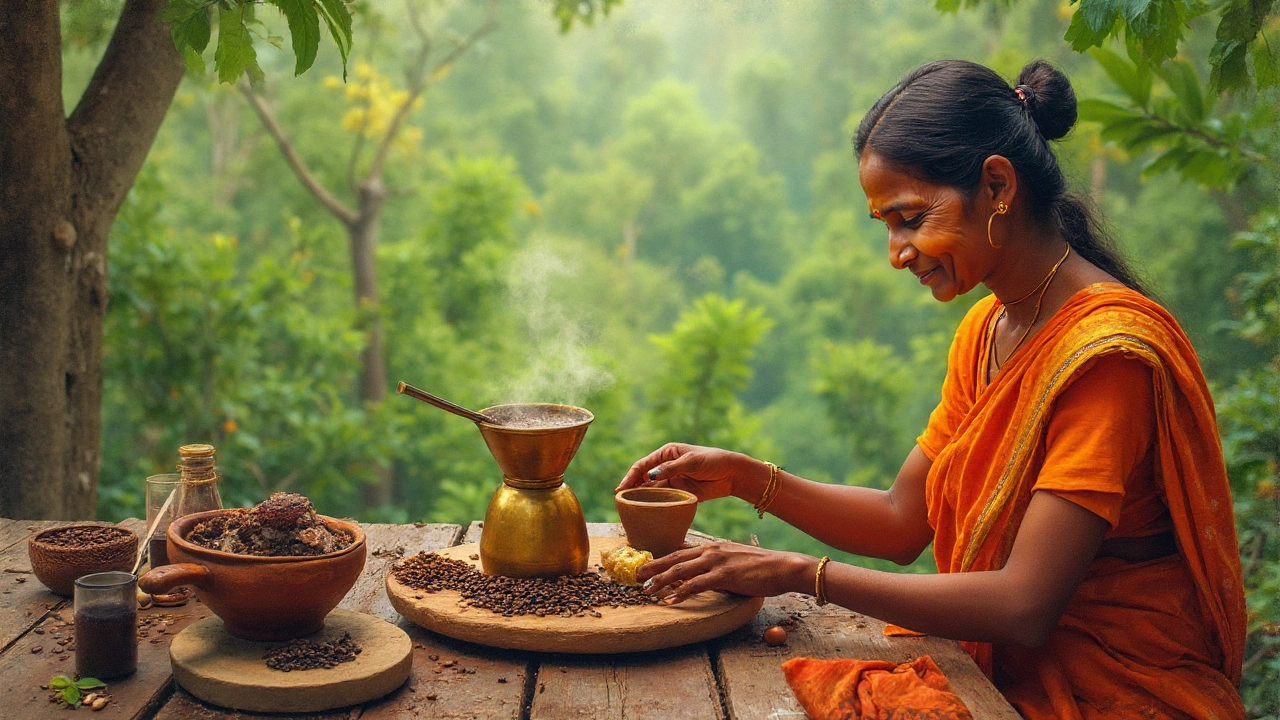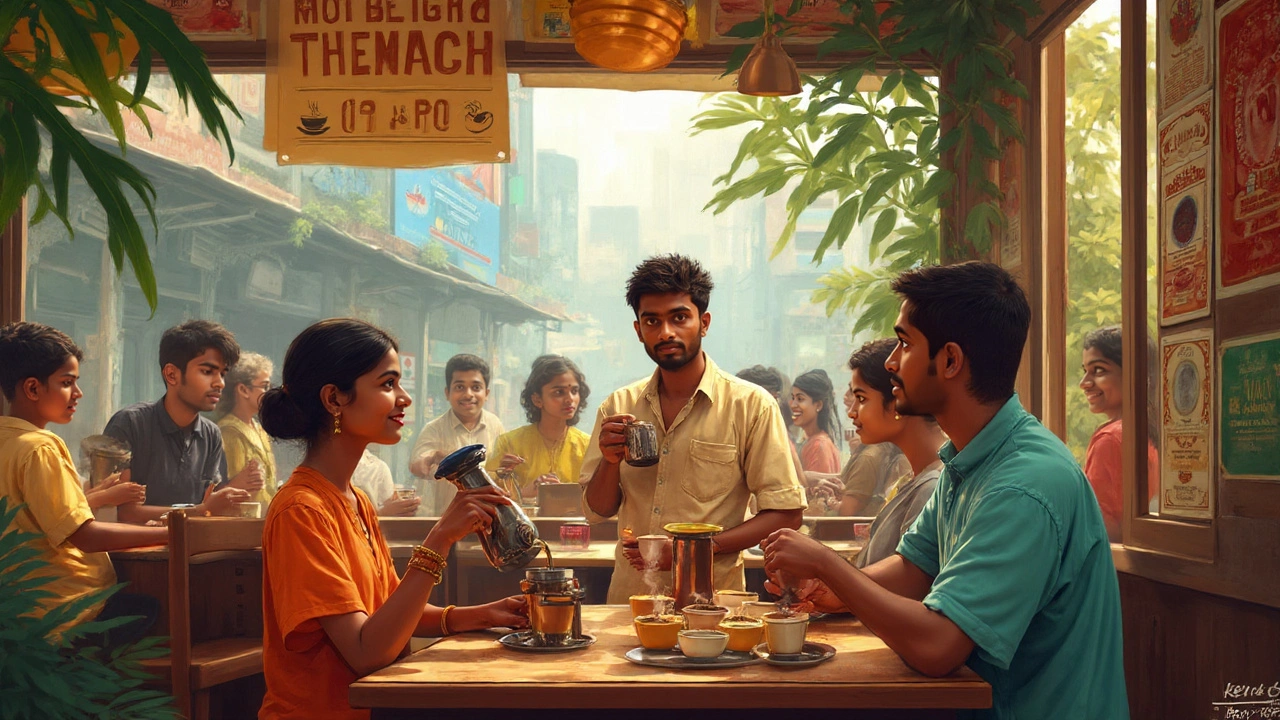If you think India is all about tea, you’re missing half the story. Sure, masala chai is king on the streets, but coffee is quietly making its own noise—sometimes literally, as grinders whirr at bustling South Indian cafés or hipster coffee bars in Mumbai crank out cold brew. The question isn’t really ‘can’ you drink coffee in India. It’s absolutely possible—maybe even necessary, especially after a long journey or a spicy meal that needs a friend. The question is, how do you find it, what kinds will you get, and is it safe to drink? Let’s get that all sorted out.
Coffee’s Wild Ride in India: More Than Just South Indian Filters
The story starts with Baba Budan, a 17th-century Sufi saint who supposedly smuggled coffee beans into southern India from Yemen—tucked into his beard, or so the legend goes. Today, those beans have multiplied. According to the Coffee Board of India, the country produced 3,74,000 metric tonnes of coffee in the harvest year 2023-2024, putting it among the world’s top ten coffee producers. Plus, most of that coffee comes from stunning, rain-soaked plantations in Karnataka, Kerala, and Tamil Nadu—and surprise, it’s mostly shade-grown, so it’s pretty eco-friendly too.
South India truly owns the filter coffee game. Walk into any home or the thousands of iconic “darshan” coffee houses, and you’ll find a ritual that’s hard to beat. Roasted beans are ground fresh, brewed slowly with a metal filter, and then blended with hot milk and sugar. The result? A small, steel tumbler (sometimes with a jug called a "dabara") full of rich, frothy coffee that you pour back and forth to cool. It’s warm, comforting, and has a unique flavor—you’l get a bit of chicory in the mix, which some love and others find a little earthy.
Head to the north, and the preference is often tea, but coffee’s making a push. In big cities like Delhi, Mumbai, and Bangalore, you’ll run into Starbucks, Café Coffee Day (India’s own coffee chain with over 500 outlets), and third-wave coffee bars that wouldn’t be out of place in Melbourne or Brooklyn. Want to feel like a local? Try a roadside “instant coffee” shot (think Nescafé or Bru, whisked up frothy with sugar and powdered milk). It’s not fancy, but it’s oddly comforting—especially if you’re waiting for a bus at 2AM.
Finding Good Coffee: Where to Go and What to Order
A lot of people are surprised at how easy it is to find coffee in India these days, from remote hillsides to city malls. But if you’re looking for the best experience, try to get a sense of place: what’s brewed in Tamil Nadu is not what you’ll get in Darjeeling.
For a true taste of southern tradition, seek out a local “coffee bar” or “darshini” if you’re in Chennai, Bangalore, or Mysore. Skip the menu and ask for “filter coffee”—no one ever calls it "drip" here. If you’re new to mixing sugar and coffee, just say how sweet you want it (“less sugar” is a good lifeline). The cups may look small, but the caffeine hit is big. Tipping isn’t expected for street-side coffee, but it’s always appreciated in sit-down cafés.
Traveling through the backroads of Karnataka? Don’t miss a plantation tour. Coffee estates there are often open for visitors, and some offer fresh brew tastings (along with anecdotes about leopards and monsoons). In Kerala’s Wayanad, try coffee paired with local spice cakes, or head to Hyderabad’s “Irani cafes” for a unique city spin on the classic brew.
Modern Indian cities now have indie cafés serving single-origin coffee, espresso, cold brew, and even Vietnamese egg coffee. Chains like Blue Tokai, Third Wave Coffee, and Black Baza are popping up in tech hubs and college neighborhoods. These shops often roast their own beans, and you can grab a sack to take home.
One thing to watch: instant coffee still rules in less urban spots and budget hotels. If you’re a coffee snob, bring your own pour-over kit or a travel French press. Powdered milk is common in small eateries, but you can sometimes request “fresh milk coffee” instead. And forget about decaf in rural places—it’s rare outside high-end hotel cafés.
| Region | Popular Coffee Style | Where To Try |
|---|---|---|
| Karnataka | Filter Coffee | Local Darshinis, Coffee Estates |
| Tamil Nadu | Chicory-Blend Filter Coffee | Traditional Cafés (e.g. Saravana Bhavan) |
| Kerala | Spice-Infused Coffee | Wayanad Homestays, Plantation Tours |
| Delhi/Mumbai/Bangalore | Cappuccino, Cold Brew, Espresso | Indie Coffee Shops/Chains |
| Street/Highway | Instant Coffee | Nescafé Stalls, Roadside Shops |

Is It Safe to Drink? Hygiene, Water, and Other Practical Things
Let’s talk safety. Is it safe for foreigners to drink coffee in India? Mostly, yes—but with a few common-sense checks. Coffee is almost always made with boiled water, so that zaps a lot of germs. Milk, on the other hand, can be tricky. In well-established cafés, big hotels, and branded outlets, you’re in good hands—milk is pasteurized, machines are clean, and you’re unlikely to run into trouble.
Where you might need to be careful is at roadside coffee carts or small hole-in-the-wall joints, especially outside tourist hotspots. If you see milk sitting out in the open or the stall looks iffy, trust your gut. Ordering black coffee ("kaapi nalla black" in the south) is a safe bet if you’re worried. Or, ask for “hot milk only.” Street coffee is always meant to be consumed hot; a cold or lukewarm cup is a red flag—walk away.
The cup itself might be made of anything from stainless steel to ceramic or even disposable plastic. If a place washes its glasses with filtered water, you’re golden. Tap water in India can be risky, so if you see ice, skip it.
Here are a few tips to keep things easy and hygienic:
- Watch how your coffee is made. If the stall uses mineral water and boils milk properly, you’re good.
- Ask for no ice or cold water added.
- Stick to hot, fresh coffee. Avoid anything that’s been sitting out.
- Pack your own cup and coffee sachets for rural areas.
- At airports and train stations, branded beverage kiosks are safer than random stalls.
Don’t let rare horror stories spook you; millions drink coffee safely on Indian streets every single day—including local kids, aunties, and traveling businesspeople. If you have a sensitive stomach, stick to cleaner places and bottled drinks. But if you aim for the places with a steady crowd, your coffee adventure should be worry-free.
Coffee Culture Shifts: Indian Trends, Regional Surprises, and What’s Next
The real fun is seeing how fast India’s coffee scene is evolving. “Third wave” coffee culture is now a real thing in cities. Cafés host poetry nights and coffee-tasting workshops. Bangalore’s Whitefield and Mumbai’s Bandra are packed with hip bars using aero-presses and pour-overs, sometimes launching special seasonal blends with notes of pepper or coconut. You can even buy Indian-grown “specialty” beans on Amazon or from brands like Blue Tokai and Araku.
If you want to take something home, pick up monsoon Malabar beans for a unique, naturally processed taste that’s distinct from African or South American coffees. Gourmet options often come with tasting notes like “earthy, nutty, with a bite of spice,” which pair surprisingly well with traditional sweets or even samosas—don’t knock it till you’ve tried.
It’s not just adults—Gen Z and young Indians see coffee as a lifestyle symbol now. Cafés are places to hang out, work, date, game, and network. Laptops everywhere, fast WiFi, latte art—it’s the new normal in major towns. On the flip side, old-timers still nurse a ritual cup of south Indian filter coffee at sunrise, letting the day gently unwind. Both camps love a good brew; they just want it in their own way.
If you’re in India around harvest season (around November to March), certain regions throw coffee festivals. In Coorg, celebrations spill out onto the streets with coffee-tasting booths. Bangalore and Hyderabad have barista championships that pull in global visitors. So, there’s always something brewing. Yes, you can drink coffee in India—it might just become your new favorite part of the trip.
So next time someone says India is all about chai, you’ll know better. Grab a steaming cup, sit out on a veranda, and watch the world go by. That’s the Indian coffee experience at its best.
